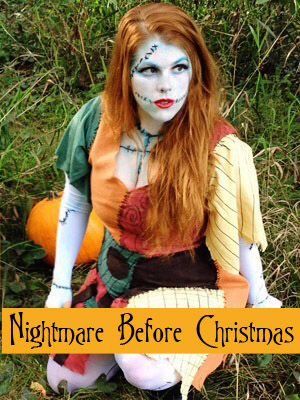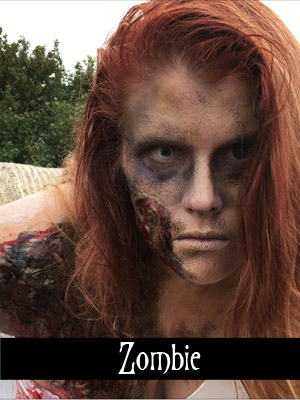It’s usually when you think things are “Going so well!” when the suddenly aren’t anymore. I’ve been struggling with my neck pain for about a month now, and this week, it started to be too much. After multiple migraines and far more visits to the chiropractor that I really cared for (read: no money!) and some quality time laying down and icing, I think i’m ready to jump back into my month of Halloween! I’ve got a few fun things in the works to make up for the down time, don’t you worry!
Sally Costume Tutorial
I was so excited about making my own sally dress from scratch, I got started on it a month ago, just to make sure I could get it done in time for the first week of October (which technically it still is the first week of October, so, close enough?). And… im glad I started when I did. This ended up taking a little more time than I had bargained for, granted, I could have been far faster with it if need be. That all said, it was SO WORTH IT!
Gather Your Supplies
While the actual supplies and fabric you may use on your costume can vary, check out this list for all of the items you will need to pull of the completed look. I will follow up soon with the Makeup Tutorial!
Prepping the Dress
Because I am by no means a seamstress and also do not happen to have a sewing machine, I decided to use an old dress that still fits as a base for the dress and apply the costume fabric over the dress to ensure that the full costume would 1) Fit properly and 2) not fall apart i.e. costume malfunctions.
Sleeves
This particular dress had 3/4 sleeves, so I started by cutting off the fabric so there was only a cap sleeve remaining. The edges will be covered by the costume fabric, so you won’t need to worry about hemming the edges. You could also go for a complete sleeveless edge, but I wanted to make sure that there was a bit of fabric under the new sleeves, just in case i needed to pull a little to get it on/off.
Hemline
The length of this dress was also far longer than I wanted for my costume, so this was also due for a trim. Whenever hemming length, its always best to first pin up the front and put the dress on so you can make sure the new pinned length isn’t too short. Once you have it where you want it, flip the dress inside out and mark (with chalk or a pen, if it will show up) the same amount around the full circumference of the skirt. It helps to have a ruler and measure the same distance up every couple of inches around the skirt, then connect the marks or simply use them for reference when cutting so you get an even cut all the way around. Again, you won’t need to worry about how pretty the cut is since we will be covering this with the costume fabric as well.
Neckline
Finally, asses your neckline. Sally has a V neck, but you could certainly change this if it would’t be flattering on you! I didn’t have to make any adjustments to my dress, but you might want to cut the neck of the dress so that it will represent the neckline you want the final costume to have.
Cutting & Laying the Fabric
The easiest way to describe the process was that I first lay and cut all of my fabric being really generous with extra room for each piece, just to ensure there is enough when it is sewn down. Its a lot easier to cut it off than add it back on. Once each piece was cut, I then safety pinned it to the dress before moving to the next one for reference. After I had the dress structured with safety pins, I then went through and began to attach them to the base dress.
These rough diagrams show the order in which I cut and attached each piece, and I followed the same order when going back through and sewing them on. You might have to unpin other pieces as you attach each, but I felt this process ensured I wouldn’t back myself into a corner with a mistake that would be difficult to fix later on. I have further instructions corresponding to each piece following.
Pieces 1-4
Since the top of the dress would be the most fitted, I started here and worked my way down. It also helps to reference a picture of Sally while you do this to make sure you are selecting the right fabric. You can use my dress as a “map” for where similarly colored fabrics should go, or reference an image of Sally.
Lay the fabric down over the particular section of dress you will be covering, ensuring you leave at least 1 inch of extra at each “seam.” When doing this for 1 & 2 on the front, I simply lay lay the fabric with one edge down the middle (with one inch overlapping to the other side and completely ignoring the neckline for the moment) and cut the side and bottom of the fabric according to the width of the dress and how far down I wanted this piece to go. For the most flattering look, I tried to get the length right around where my waist would be.
Once the fabric is cut, pin it along the “seam” lines and along the neckline. It is important to make sure the dress is completely flat during this part so that you don’t short change yourself on fabric, which can make it really hard to get into the dress later (*keep reading for more on this). After the fabric is pinned, you can cut out the extra from the neckline, again, making sure there is a little overlap in the fabric so you can fold it under the base dress.
After pinning both halves of the front, flip the dress over and do the back. I also recommend leaving two inches on the two outside seams of the dress when measuring this* as it will save you a lot of hassle if you do short yourself a little on fabric. Cut an pin these pieces as well.
I also want to note, don’t feel stuck if the color combo you chose doesn’t work. I had selected a different color for the left side of the bust originally, but once i had it pinned, I just didn’t like it. Since it was only pinned, however, all I had to do was remove it and remeasure those pieces in a different color.
Pieces 5 & 6
The sleeves are fairly quick! Measure your fabric for each sleeve starting on the innermost corner and stretching along the sleeve until you reach the top shoulder seam and pin. Then do the same along the back side, and pin again. Make sure to leave a little extra fabric on each side. As for length of the sleeve, that is totally up to you. I left mine pretty long until the very end so I could adjust once the full dress was complete.
6) Also, you can ignore the stripes on the yellow sleeve for now and add them with a sharpie right before you actually sew it on, or after the dress is done.
Pieces 7, 8, & 9
I started adding the layers of the skirt working from the top down, using the edges of the new skirt pieces to make a V like shape at the bottom of the bust section. Again, make sure the skirt is flat during this part, then pin along all edges of each piece of fabric.
7) Green Stripes w Dots
Along the right side of the dress, Sally has a green striped piece with two or three large dots. For this, I only measured and pinned the green fabric, and left the details for later. Once the dress was nearly complete and sewn, I used a cup to trace out two large circles from my brown fabric, and drew on the lines using a sharpie.
Pieces 10, 11, 12, & 13
Following the edges of the previous pieces, layer on this next “row” and pin them down as well. Pay attention to length, as these will likely dictate the total skirt length, though you can adjust the hem length later if it is too long.
10) Red with thick stripes.
Similar to how I approached the green, I simply measured my base layer of the red fabric and pinned and sewed this part before attempting the stripes. Since these were pretty thick stripes, I decided to also cut these from my brown fabric, and used the hem tape to attach them in the diagonal pattern to the red fabric.
13) Yellow Cross-hatch
The other yellow section had more of a “plaid” look. I left it yellow until I was ready to sew this on. Before sewing, I used a rule to add the hatching with a sharpie.
Pieces 14, 15, & 16
These are the last pieces! Cut out the patches to a suitable size and attach with pins.
14) Yellow dots
This is for the half circle at the very bottom of the Red stripe portion. Before attaching this over the red and stripes, I cut the yellow as a square and left it alone until I had everything else the way I wanted it. Then, before I started any sewing, I added the dots using a sharpie. Before attaching, lay on top of red fabric where you will be sewing it on and then cut the rounded top as you see fit.
Spot Check!
Now that you have the full dress pinned, try it on to make sure that you have given yourself enough room to get into the dress, as its much easier to move pins now than have to pull out a stitch and add more fabric later, which I ended up having to do for the bust.
It doesn’t look so hot when it’s just pinned. Be patient! It’s coming along great!
Attaching/Sewing the Fabric
Here is where I employed a little hem tape magic. Since we will be sewing with the embroidery thread shortly, I simply used hem tape and an iron to make smooth hemmed edges for certain fabric edges, although I did leave quite a few of the fabric edges frayed as it really did fit the overall look! I then used the hem tape again to actually bond the fabric to the dress. For pieces that I felt would get the most stress, particularly the top pieces (1-4) I did use a needle and thread and throw in a few stitches ever 3-4 inches around the edges of the fabric, just for peace of mind.
Continue working your way from the top down following the same number order and adhere the cloth to the dress with the hem tape. The only exception to this is the bottom hem of the bottom row of fabric (10-13) so that it can flow naturally.
Adding the Stitches
Sally’s dress is just as stitched together as she is, so I used embroidery thread to really finish the look as well as stitch the dress together. Guys, invest in a thimble. I cannot tell you how many times I jabbed myself because of one of the fabrics. In my case, the green fabric was very flowey but in my opinion, nearly bullet proof. A thimble would have saved my poor fingers some agony.
This is going to be most time consuming part, as you will need to stitch along every seam where your fabric meets, the only exceptions being the neckline, bottom hem, and sleeve hems. Feel free to angle these stitches randomly and throw in an “X” stitch ever 2-4 stitches. This is a great time to bunker down on the couch with some blankets and pop in Nightmare Before Christmas or any other favorite flicks while you work.
Try it On!
Finally, you can try on the dress! If you are lucky, you will be able to move on to the last step of finishing touches. If you were like me, you might have to make some adjustments to get into the dress. My sewing did not include darting at the bust, and I barely got into it the first time. I completely forgot about the girls! I was able to undo a stitch next to piece one and add a two inch strip of the same red down the side, as well as an upside down triangle in the arm pit which gave me enough room in the end to get it on and off comfortably.
Finishing Touches
I went through at this point and added a lot of the details mentioned above that were specific to a portion of fabric, such as the dark spots and stripes on 7, as well as the stripes on the sleeve 6. I made sure the hem line was where I wanted it and made a few trims, then cut the ends of the sleeve so they were jagged. The last part I completed was the swirl design on pieces 1 and 4 with a sharpie, referencing a picture of Sally as I did so.
And that’s it! Whew! I also have a quick tutorial on how I did Sally’s Arms & Legs!
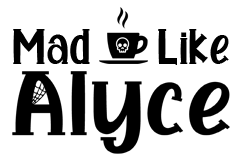


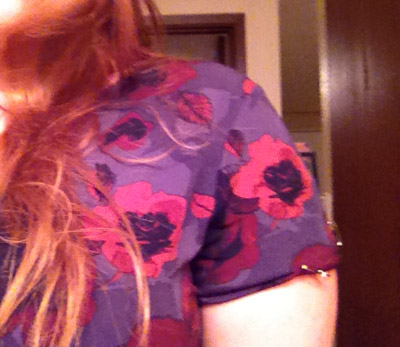






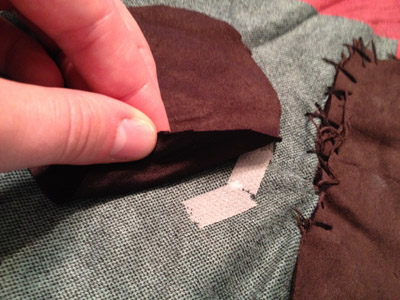
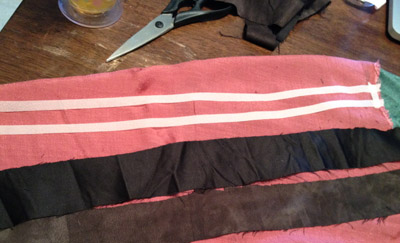

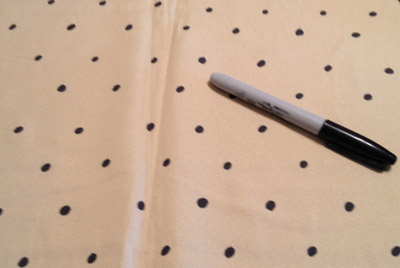
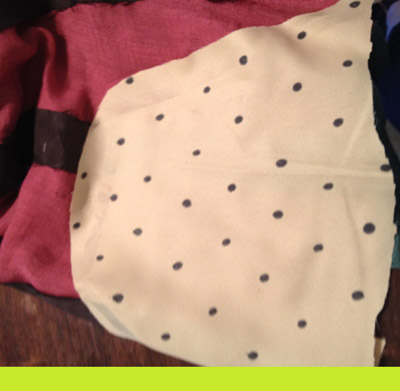

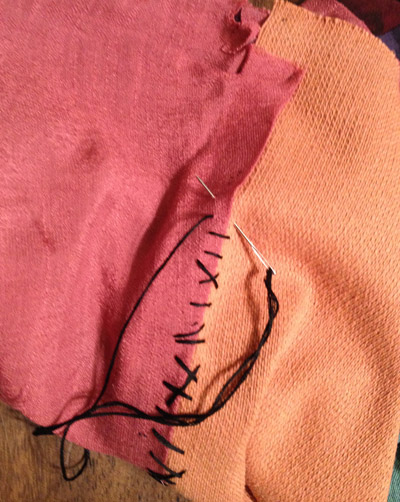
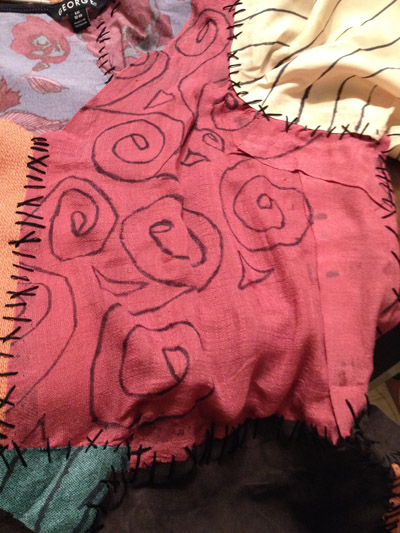
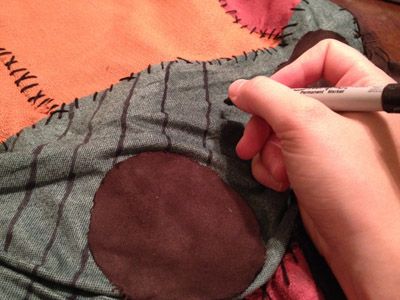
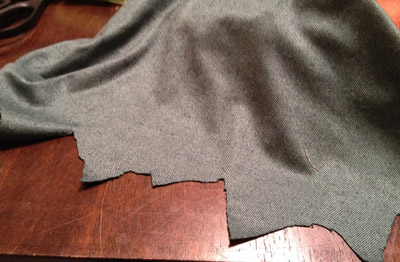
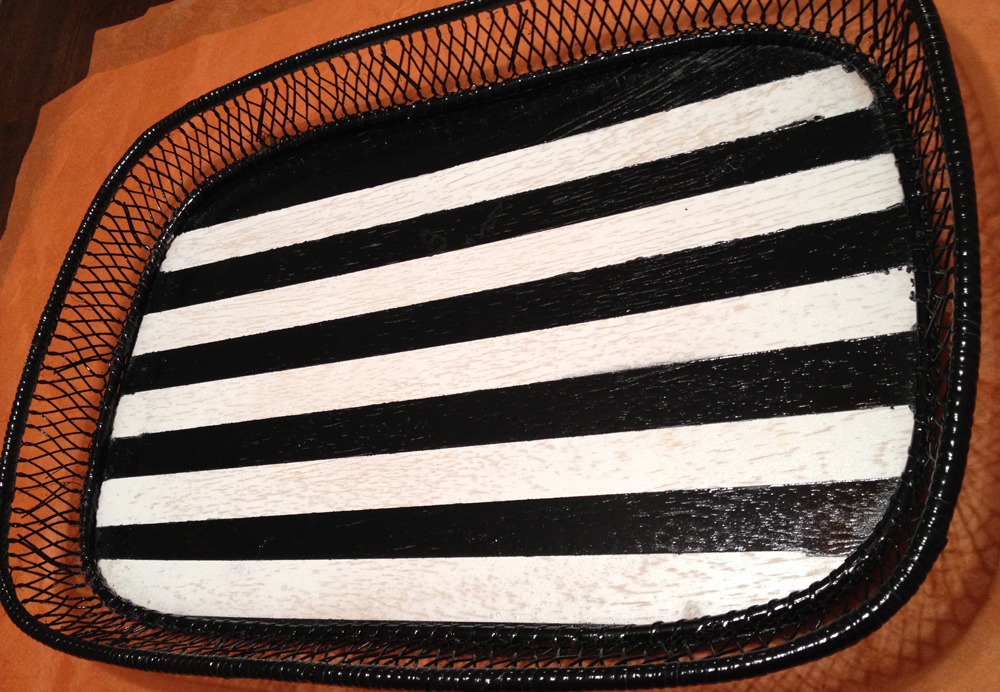


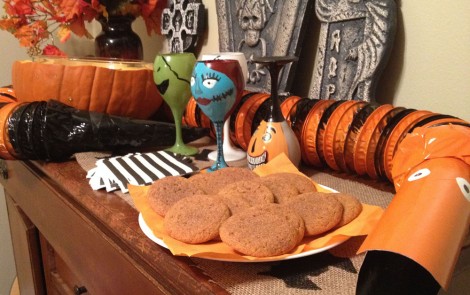

 Hi! I'm Alyce.
Hi! I'm Alyce. 